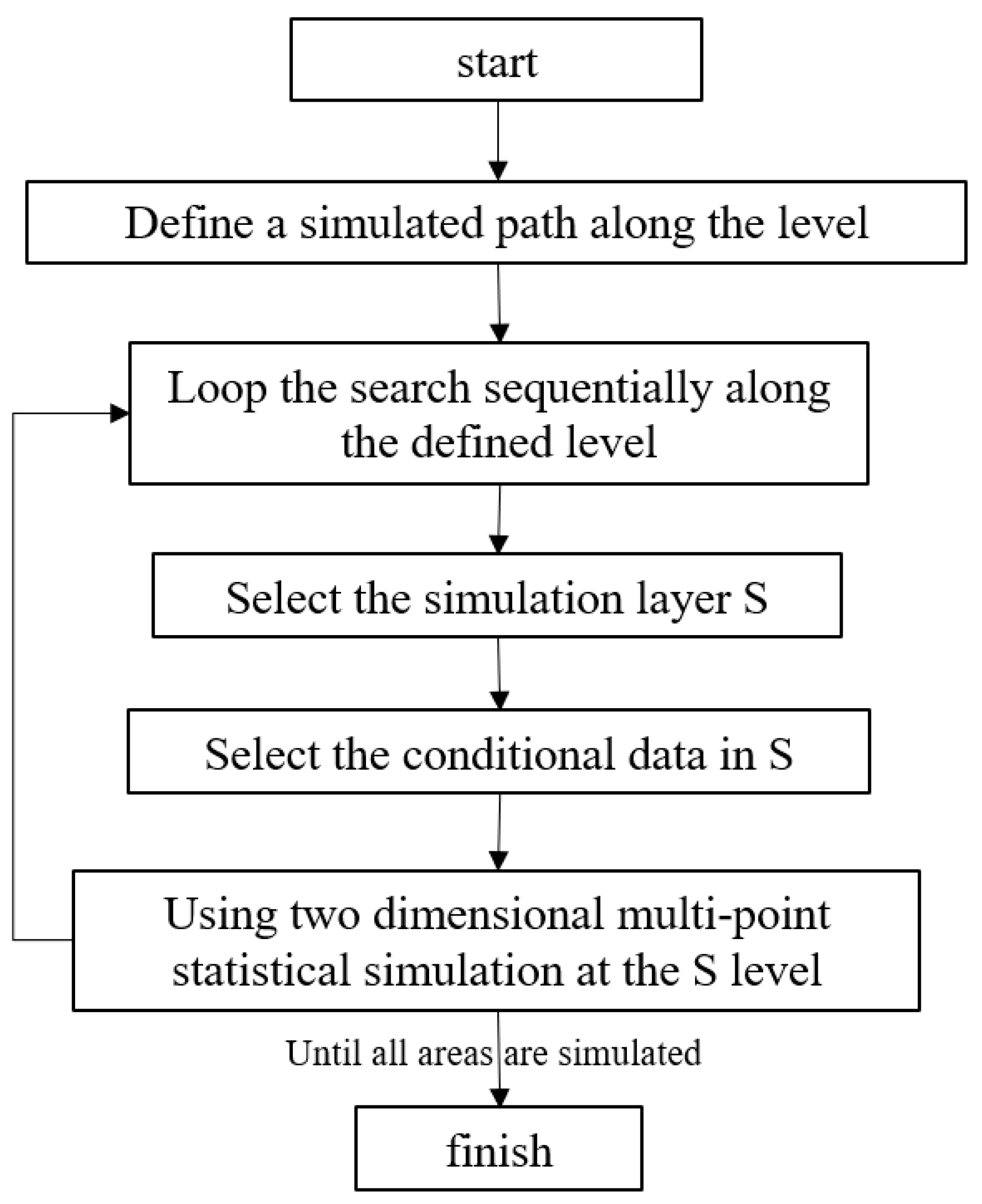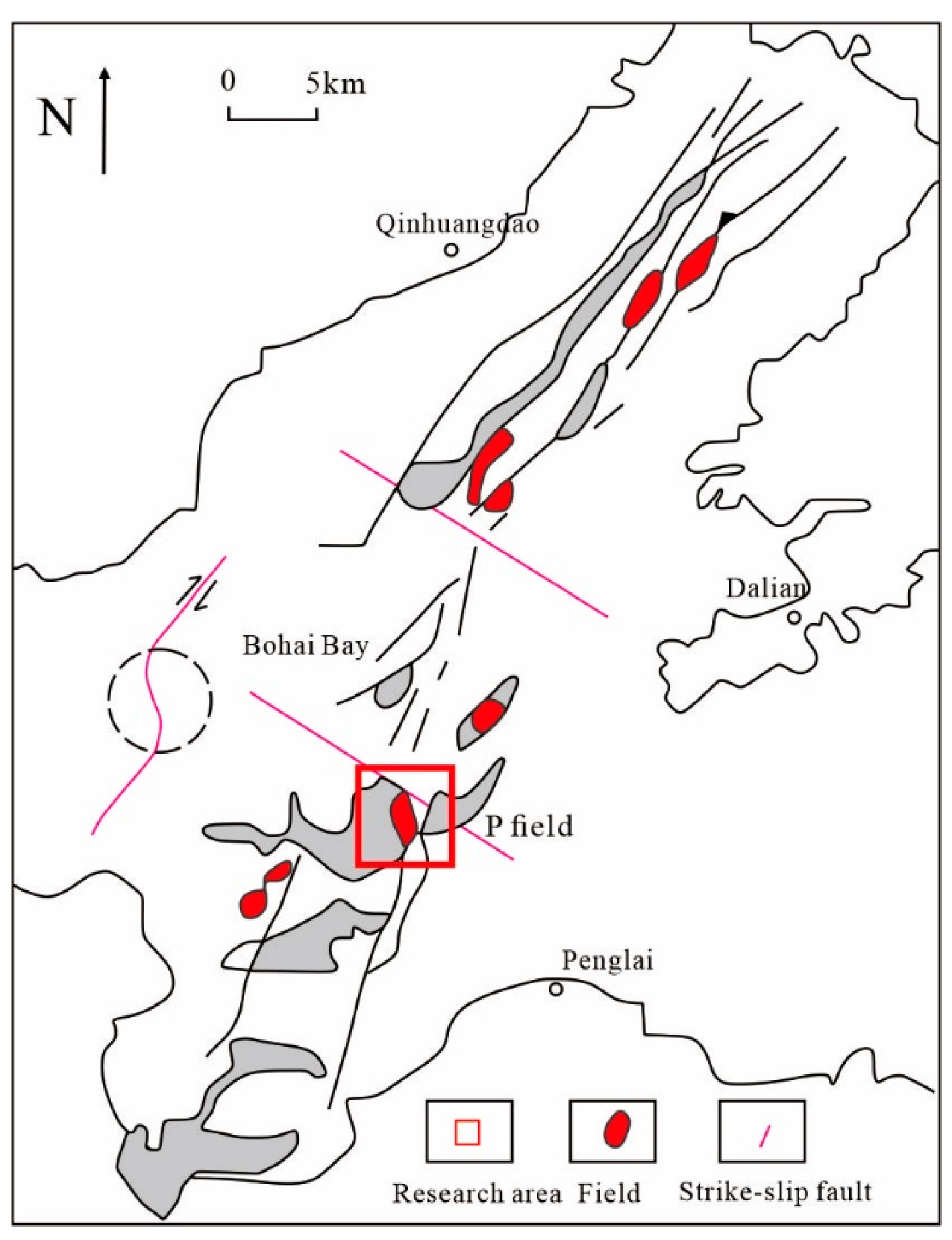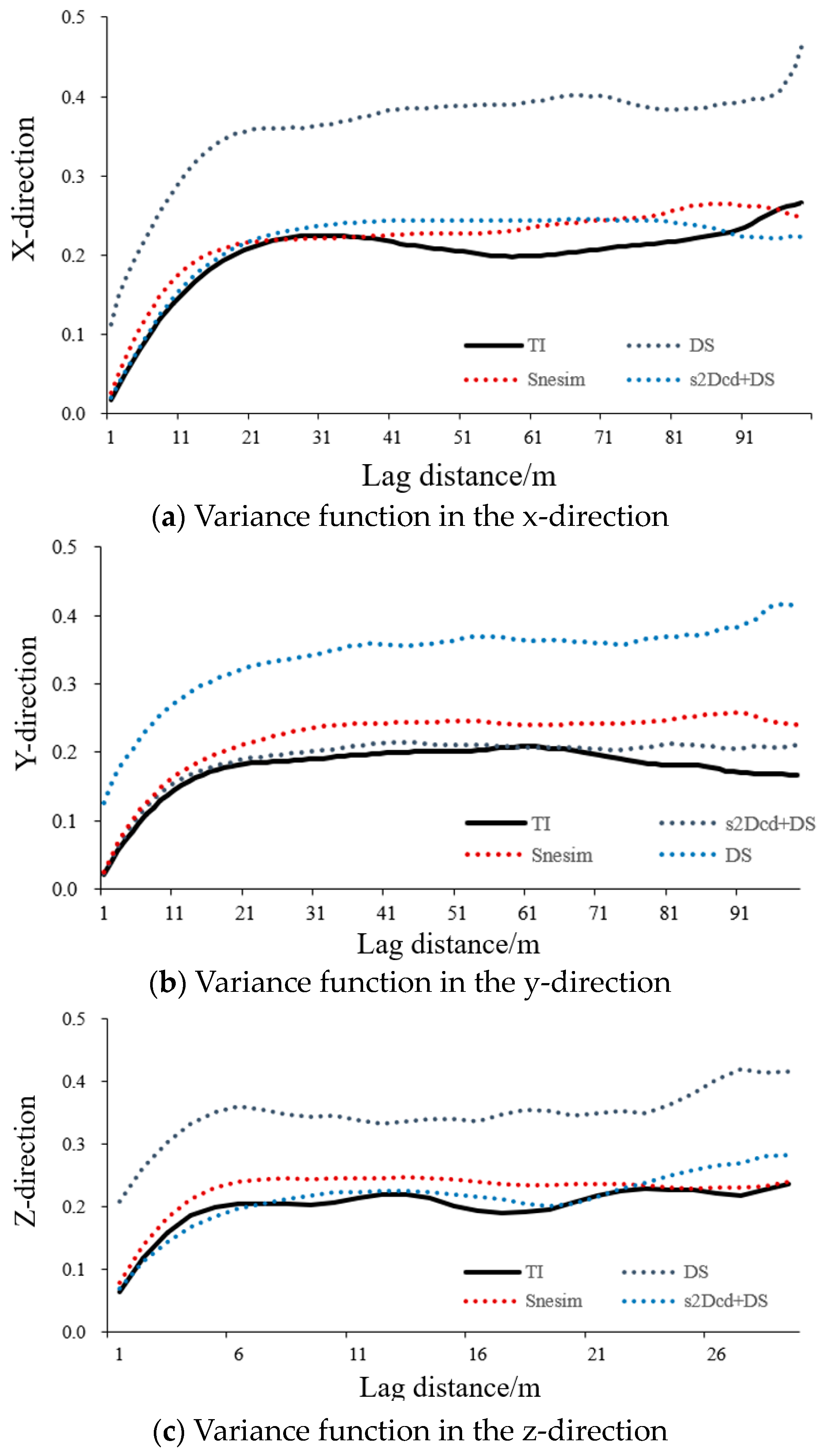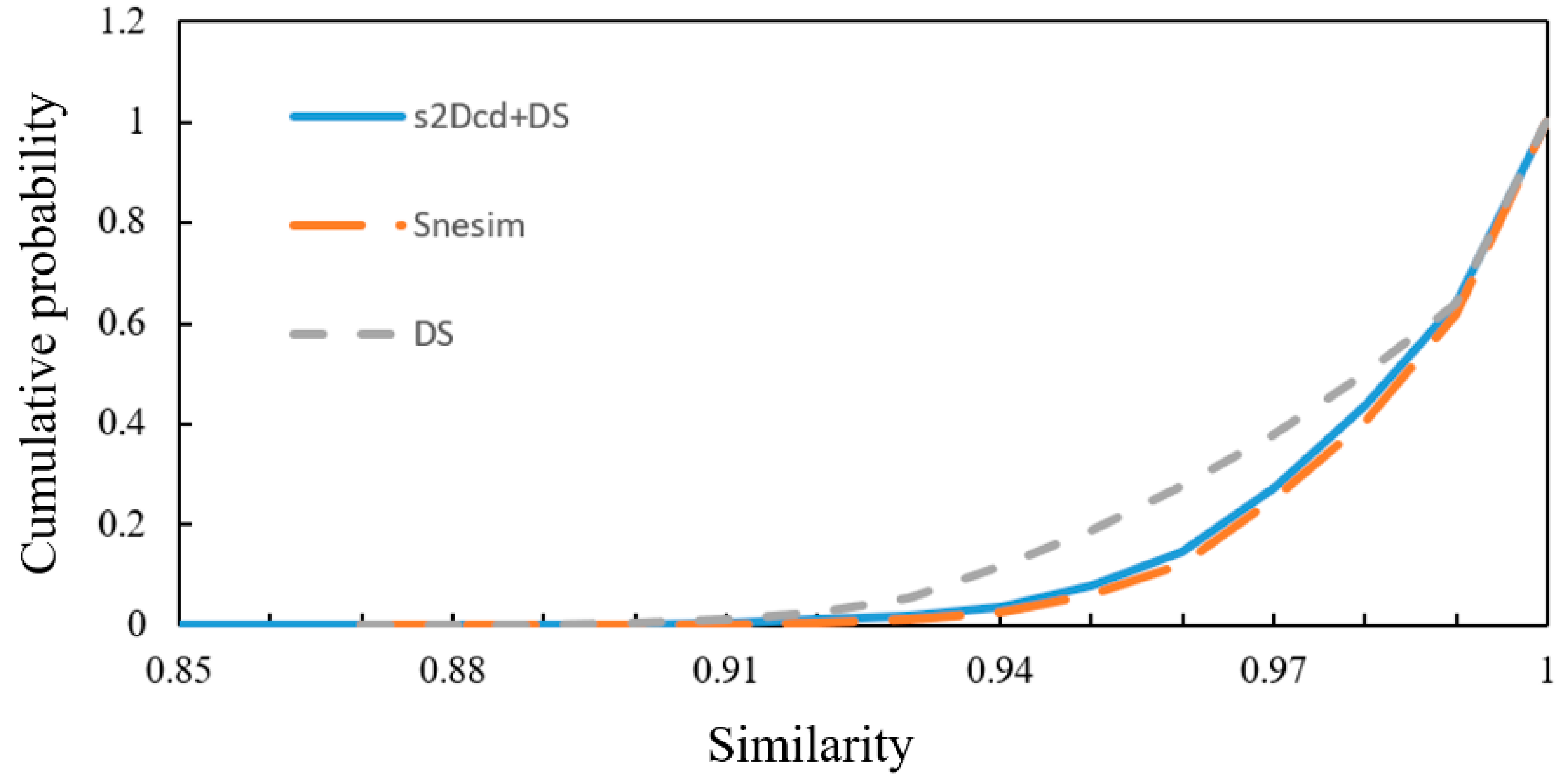Constructing of 3D Fluvial Reservoir Model Based on 2D Training Images
Abstract
:1. Introduction
Introduction to the s2Dcd+DS Algorithm
| Algorithm 1. s2Dcd+DS Algorithm Step | |
| 1. INPUT TIs, condition datas(cds) | |
| 2. INPUT analog mesh SG to achieve size | |
| 3. DEFINE ,radius_search,threads, Maxscan_Franction | |
| 4. | IMPORT the conditional data into SG according to the size of the simulated grid and the coordinates of each conditional data in the cds |
| 5. DEFINE setp_max | |
| 6. WHILE true | |
| 7. IF path_SG all simulation sequences have been accessed | |
| 8. break WHILE LOOP | |
| 9. END IF | |
| 10. Create s2Dcd 2D simulation sequence | |
| 11. x ← path SG’s next simulation sequence | |
| 12. IF x is within the range defined setp_max | |
| 13. IF The x simulation sequence contains cds, which is used as a constraint | |
| 14. do Direct Sampling multipoint simulation | |
| 15. ELSE | |
| 16. | The intersection location data of the previous simulated sequence is taken as the cds |
| 17. do Direct Sampling multipoint simulation | |
| 18. END IF | |
| 19. OUTPUT model | |
| 20. END DO | |
2. Three-Dimensional Condition Simulation of Fluvial Facies Reservoir
3. Comparative Analysis
3.1. Variance Function
3.2. Connectivity
3.3. Style Similarity
4. Conclusions
- (1)
- Previously, in the direction of digital cores, the target-based method, process-based method, simulated annealing method, and stochastic modeling method were applied to construct 3D training images using 2D training images, and it is difficult to apply these methods to construct 3D training images in the direction of reservoir modeling. To overcome this difficulty, the new algorithm in this paper integrates the s2Dcd algorithm and DS algorithm, combining the advantages of sequential 2D conditional simulation and direct sampling simulation methods. In this paper, the new algorithm combines the advantages of sequential two-dimensional conditional simulation and direct sampling simulation methods, weakens the influence of conditional data, reduces the simulation error, and realizes the construction of a three-dimensional fluvial facies reservoir model based on two-dimensional training images.
- (2)
- By comparing the variance functions, the horizontal and vertical connectivity in the x-, y-, and z-directions, and the style similarity, the results show that the new modeling method proposed in this paper can achieve the effect of approximate direct 3D training image based on several mutually perpendicular 2D training images, using multiple slices to realize the conditional simulation of the fluvial facies model. In the case where it is difficult to obtain 3D training images, the new modeling method proposed in this paper has suitable prospects for application in the direction of reservoir modeling.
- (3)
- We have been on the way to training image reconstruction, and multipoint geostatistics has been developing. The new method in this paper is difficult to obtain 3D training images in the direction of reservoir modeling and has a suitable application prospect. We hope that in the near future, our methods will become more and more advanced and provide great value for reservoir recovery.
Author Contributions
Funding
Institutional Review Board Statement
Informed Consent Statement
Data Availability Statement
Acknowledgments
Conflicts of Interest
References
- Wang, K.; Xiao, F. Multiple-Points Geostatistics: A Review of Theories, Method and Applications. J. Geol. Sci. Technol. Intell. 2019, 38, 256–268. [Google Scholar] [CrossRef]
- Yu, M. Construction and Application of Multi-Point Geostatistics 3D Training Image for the Calculation of Bread Mineral Resources. Master’s Thesis, Jiangxi University of Science and Technology, Ganzhou, China, 2022. [Google Scholar] [CrossRef]
- Yang, P. Geostatistics inversion—From two-point to multiple-point. Prog. Geophys. 2014, 29, 2293–2300. (In Chinese) [Google Scholar]
- Wang, M.; Shang, X.; Duan, T. A Review of the Establishment Methods of Training Image in Multi-point Statistics Modeling. Geol. J. China Univ. 2022, 28, 96103. [Google Scholar] [CrossRef]
- Chen, J.Y.; Yu, X.H.; Zhang, Z.J.; Li, L.S.; Mao, Z.G. Application of reservoir geological modeling in reservoir description. Daqing Pet. Geol. Dev. 2005, 24, 17–18. [Google Scholar]
- Hu, X.; Xiong, Q.; Wu, S. Research progress of reservoir modeling methods. J. Univ. Pet. (Nat. Sci. Ed.) 2001, 25, 107–112. [Google Scholar]
- Hidajat, I.; Rastogi, A.; Singh, M.; Mohanty, K.K. Transport Properties of Porous Media Reconstructed from Thin-Sections. SPE J. 2002, 7, 40–48. [Google Scholar] [CrossRef]
- Keehm, Y.; Mukerji, T.; Nur, A. Permeability prediction from thin sections: 3D reconstruction and Lattice-Boltzmann flow simulation. Geophys. Res. Lett. 2004, 31. [Google Scholar] [CrossRef]
- Zhu, Y.; Tao, G.; Fang, W. Application of image processing technology in digital core modeling. J. Oil Gas Technol. 2007, 101, 54–57+166. [Google Scholar]
- Liu, X.-F.; Zhang, W.-W.; Sun, J.M. Methods of constructing 3-D digital cores: A review. Prog. Geophys. 2013, 28, 3066–3072. (In Chinese) [Google Scholar] [CrossRef]
- Wang, Z. Application of modern sedimentary and close well pattern data building training image in phase modeling. China Pet. Chem. Stand. Qual. 2018, 38, 121–122. [Google Scholar]
- Bao, H.S.; Han, T.C.; Fu, L.Y. Calculation method of digital rock electrical conductivity based on two-dimensional images. Chin. J. Geophys. 2021, 64, 1733–1744. (In Chinese) [Google Scholar] [CrossRef]
- Liang, Z.; Ioannidis, M.A.; Chatzis, I. Permeability and electrical conductivity of porous media from 3D stochastic replicas of the microstructure. Chem. Eng. Sci. 2000, 55, 5247–5262. [Google Scholar] [CrossRef]
- Mo, X.W.; Zhang, Q.; Lu, J.A. A complement optimization scheme to establish the digital core model based on the simulated annealing method. Chin. J. Geophys. 2016, 59, 1831–1838. (In Chinese) [Google Scholar] [CrossRef]
- Comunian, A.; Renard, P.; Straubhaar, J. 3D multiple-point statistics simulation using 2D training images. Comput. Geosci. 2012, 40, 49–65. [Google Scholar] [CrossRef] [Green Version]
- Mariethoz, G.; Renard, P. Reconstruction of Incomplete Data Sets or Images Using Direct Sampling. Math. Geosci. 2010, 42, 245–268. [Google Scholar] [CrossRef] [Green Version]
- Geng, L.; Hou, J.; Li, Y.; Li, Z.; Qu, P. Application of DS-MPS Algorithm in the Modeling of Reservoir Sedimentary Facieses. Pet. Geol. Oilfield Dev. Daqing 2015, 34, 24–29. [Google Scholar]
- Liu, Y. Research progress of multi-point geostatistics in fluvial facies modeling. Sci. Technol. Inf. 2012, 160–161. [Google Scholar]
- Wu, S.; Jin, Z.; Huang, C.; Chen, C. Reservoir Modeling; Petroleum Industry Press: Beijing, China, 1999. [Google Scholar]
- Wang, J.; Zhang, T. Stochastic Modeling of Oil and Gas Reservoir; Petroleum Industry Press: Beijing, China, 2001. [Google Scholar]
- Gueting, N.; Caers, J.; Comunian, A.; Vanderborght, J.; Englert, A. Reconstruction of Three-Dimensional Aquifer Heterogeneity from Two-Dimensional Geophysical Data. Math. Geosci. 2018, 50, 53–75. [Google Scholar] [CrossRef] [Green Version]
- Yu, S.; Li, S.; Wang, D.; Wang, J.; Zhang, Y.; Yu, J. Multipoint geo-statistical modeling algorithm based on p-stable LSH. Acta Pet. Sincia 2017, 38, 1425–1433. [Google Scholar]














| Sedimentary Facies | Rock Type | Color | Sedimentary Structure | Structural Feature | ||
|---|---|---|---|---|---|---|
| Facies | Subphase | Microphase | ||||
| Meander river | Meander channel | Edge beach | Gravelly medium sandstone, fine sandstone, and siltstone interbedded | Burgundy, brownish red, taupe | Trough cross-bedding, oblique bedding | Sorting medium, subridged, subrounded |
| Channel retention | ||||||
| Food plain | Flood plain | Mudstone, siltstone | Brownish red | Minor oblique bedding | Mainly argillaceous | |
Disclaimer/Publisher’s Note: The statements, opinions and data contained in all publications are solely those of the individual author(s) and contributor(s) and not of MDPI and/or the editor(s). MDPI and/or the editor(s) disclaim responsibility for any injury to people or property resulting from any ideas, methods, instructions or products referred to in the content. |
© 2023 by the authors. Licensee MDPI, Basel, Switzerland. This article is an open access article distributed under the terms and conditions of the Creative Commons Attribution (CC BY) license (https://creativecommons.org/licenses/by/4.0/).
Share and Cite
Li, Y.; Li, S.; Zhang, B. Constructing of 3D Fluvial Reservoir Model Based on 2D Training Images. Appl. Sci. 2023, 13, 7497. https://doi.org/10.3390/app13137497
Li Y, Li S, Zhang B. Constructing of 3D Fluvial Reservoir Model Based on 2D Training Images. Applied Sciences. 2023; 13(13):7497. https://doi.org/10.3390/app13137497
Chicago/Turabian StyleLi, Yu, Shaohua Li, and Bo Zhang. 2023. "Constructing of 3D Fluvial Reservoir Model Based on 2D Training Images" Applied Sciences 13, no. 13: 7497. https://doi.org/10.3390/app13137497
APA StyleLi, Y., Li, S., & Zhang, B. (2023). Constructing of 3D Fluvial Reservoir Model Based on 2D Training Images. Applied Sciences, 13(13), 7497. https://doi.org/10.3390/app13137497






